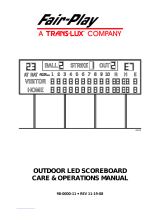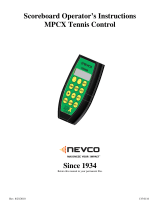Page is loading ...

Table of Contents 2
Gen V Radio
Installation Manual
ED-13831 Rev 6 – 8 November 2011
201 Daktronics Drive PO Box 5128 Brookings, SD 57006-5128
Tel: 1-800-DAKTRONICS (1-800-325-8766) Fax: 605-697-4700
Web: www.daktronics.com


ED-13831
P1322
Rev 6 – 8 November 2011
DAKTRONICS, INC.
Copyright 2007-2011
All rights reserved. While every precaution has been taken in the preparation of this manual, the publisher
assumes no responsibility for errors or omissions. No part of this book covered by the copyrights hereon may be
reproduced or copied in any form or by any means - graphic, electronic, or mechanical, including photocopying,
taping, or information storage and retrieval systems - without written permission of the publisher.
All Sport
®
is a registered trademark of Daktronics, Inc. All other trademarks are the property of their respective companies.


Table of Contents i
Table of Contents
Table of Contents .................................................................................................................................. i
Section 1: Installation ................................................................................................................... 1
1.1 Radio Receiver ......................................................................................................................... 1
Indoor Scoreboards .......................................................................................................... 1
Outdoor Scoreboards ...................................................................................................... 1
1.2 RC-100 Base Station ................................................................................................................ 1
Section 2: Setting Radio Channels ............................................................................................. 3
2.1 Radio Control Overview ........................................................................................................ 3
2.2 Typical Radio Configurations ............................................................................................... 3
Single Controller System................................................................................................. 4
Multiple Controller System with Single Broadcast Group ........................................ 5
Multiple Controller with Multiple Broadcast Groups ................................................ 7
Section 3: Daktronics Exchange and Repair & Return Programs .......................................... 9
3.1 Exchange Program .................................................................................................................. 9
Before Contacting Daktronics ........................................................................................ 9
3.2 Repair & Return Program .................................................................................................... 10
Shipping Address .......................................................................................................... 10
3.3 Daktronics Warranty and Limitation of Liability ............................................................. 10
Appendix A: Reference Drawings ................................................................................................. 11
Appendix B: Daktronics Warranty and Limitation of Liability ................................................... 13


Installation 1
Section 1: Installation
1.1 Radio Receiver
Reference Drawings:
Installation; Indoor, Gen V Radio Receiver ............................................ Drawing A-203542
Installation: Outdoor- Gen V Radio Receiver ......................................... Drawing A-203543
Install Details: Outdoor Radio/Wire Switch ............................................ Drawing B-235957
Installation; Radio Bracket ..................................................................... Drawing A-267405
Installation; Outdoor Gen IV Scbds,w/ Gen V Radio ............................. Drawing A-290166
Installation- Indoor Color Smart- Gen V Receiver ................................. Drawing A-298616
Most scoreboards will have an internal mounting bracket to which the radio receiver will be
attached. Refer to the component location drawings included in the scoreboard manual for
the radio mounting location. If a bracket was not factory-installed, refer to Drawing A-267405
for bracket installation instructions.
Indoor Scoreboards
For standard indoor scoreboards, refer to Drawing A-203542.
For ColorSmart
®
color-changing digit scoreboards, refer to Drawing A-298616.
Outdoor Scoreboards
For outdoor scoreboards built after January 2007, refer to Drawing A-290166.
For outdoor scoreboards built before January 2007, refer to Drawing A-203543.
Note: For outdoor installations that have a radio/wire switch, refer to Drawing B-235957.
1.2 RC-100 Base Station
Reference Drawings:
Base Station: Outdoor Installation ......................................................... Drawing A-236394
Outdoor Installation: Radio Receiver & Base Station .......................... Drawing A-1069855
Drawing A-236394 shows the installation of an RC-100 base station for outdoor scoreboards.
For detailed RC-100 installation and setup instructions, including indoor scoreboards, refer to
the Remote Control System RC-100 All Sport Operation Manual (ED-15133), available
online at www.daktronics.com/manuals.
In certain situations, it is possible that both an All Sport
®
radio receiver and an RC-100 base
station will be installed in the same outdoor scoreboard. For instance, a handheld RC-100
may be used when running practices, and then a wireless All Sport console would control the
scoreboard during the game. In these cases, refer to Drawing A-1069855.
Note: The wireless device that takes precedence is the one that the scoreboard receiver
finds active first, and it will control the scoreboard until the signal is no longer present.


Setting Radio Channels 3
Section 2: Setting Radio Channels
2.1 Radio Control Overview
The radio receiver units used in Daktronics scoreboards have a channel-setting switch that
can be set from 1 through 8 (channels 0, and 9-15 are not used). The receivers also have a
jumper that can be used to select a broadcast group from 1-4. The broadcast group defines a
group of radio receivers that “listen” to the channel selected on the channel switch as well as
“listen” for data sent out on their broadcast channel.
There are four broadcast groups available. Each radio receiver will accept data sent from the
broadcast channel of its respective broadcast group (either 1, 2, 3, or 4), as well as data sent
from the “Master Broadcast” channel. This is selected when the console is set to Broadcast
Group 0 (BCAST 0) and Channel 0.
The radio settings in the console (transmitter) must match the settings in the scoreboard
(receiver). By default, both devices are set to Broadcast Group 1, Channel 01. The installation
drawings in Appendix A show the proper way to set the channel and broadcast group
numbers for the receiver. The operator must then enter these specific numbers when
prompted during console startup.
To determine the settings of a scoreboard
without accessing the receiver, first power it
down and shut off any radio-equipped
consoles in the area. Next, power the
scoreboard back up and watch for the radio
settings. The settings will appear as “bX CY”
where X is the current broadcast group and Y
is the current channel.
The settings are typically displayed in the
clock digits (Figure 1) or Home and Guest
score digits (Figure 2), depending on the
scoreboard model.
The console automatically detects when a
radio transmitter is installed and will prompt
the user for transmitter settings after a valid
sport code is entered.
2.2 Typical Radio Configurations
There are three different radio scenarios that can be accommodated: a single controller
system, a multiple controller system with a single broadcast group, and a multiple controller
system with multiple broadcast groups. Each of these configurations is described in detail in
the following sections.
Figure 1: Radio Settings in Clock Digits
Figure 2: Radio Settings in Score Digits

4 Setting Radio Channels
Single Controller System
In a single controller system (Figure 3), all radio receivers and all scoreboards receive signal
from the same console at all times. The default channel and broadcast group settings on the
receiver are not typically modified. An example of this type of system is a football field with
a scoreboard in one or both end zones displaying the same information.
Typically all single controller systems will use the default setting BCAST = 1, CHAN = 1.
All jumpers in the radio receivers must be set to Broadcast 1 (BCAST 1).
Display
Action
The LCD will toggle between
these 2 screens.
The LCD shows the current radio settings along with a prompt
to accept or modify these values.
If the radio settings are correct press <ENTER>.
If these values are incorrect press <CLEAR>, and the LCD at
bottom left is shown, allowing edit of the channel or broadcast
group setting.
Broadcast Group Setting
1 Use this setting for all single controller systems. Use
the number keys to edit this value and press
<ENTER> to accept. The asterisk will move to the
channel setting.
Channel Setting
1-8 Channels 1-8 may be used with broadcast group 1.
Edit the channel number to the desired value and press
<ENTER> to accept. The channel switch on the
receiver must match this value and only the Broadcast
1 (BCAST1) jumper must be set.
Figure 3: Single Control Console
BCAST 1, CHANNEL #1
BCAST 1, CHANNEL #1
BCAST 1, CHANNEL 01
RADI O SETTI NGS
BCAST X CHAN YY
ENTER TO ACCEPT
CLEAR TO MODI FY
BCAST GROUP 1*
RADI O CHAN 01

Setting Radio Channels 5
Multiple Controller System with Single Broadcast Group
In a multiple controller system with a single broadcast group (Figure 4), there may be one
console for each scoreboard and/or one master controller that can run every scoreboard at
one time or take control of a specific scoreboard. An example of this type of system is a
softball complex with individual scoreboards on several different fields.
Figure 4: Single Broadcast Group
BCAST 1, CHANNEL #1
BCAST 1, CHANNEL #2
BCAST 1,
CHANNEL 01
BCAST 1,
CHANNEL 02
BCAST 1,
CHANNEL 03
BCAST 1, CHANNEL #3
BCAST 1, CHANNEL #4
BCAST 1,
CHANNEL 04
BCAST 0,
CHANNEL 00
to control all at once
Or
BCAST 1,
CHANNEL 01-04
to control a specific
scoreboard

6 Setting Radio Channels
Multiple controller systems typically use Broadcast 1 and Channel 1 for the first controller
and Channels 2-8 for all remaining controllers. All jumpers in the radio receivers must be set
to Broadcast 1 (BCAST 1).
Display
Action
The LCD will toggle between
these 2 screens.
The LCD shows the current radio settings along with a prompt
to accept or modify these values.
If the radio settings are correct press <ENTER>.
If these values are incorrect press <CLEAR>, and the LCD at
bottom left is shown, allowing edit of the channel or broadcast
group setting.
Broadcast Group Setting
1 Use this setting for all multiple controllers with single
broadcast group setups. Use the number keys to edit
this value and press <ENTER> to accept. The asterisk
will move to the channel setting.
Channel Setting
1-8 Channels 1-8 may be used with broadcast channel 1.
Edit the channel number to the desired value and press
<ENTER> to accept. The channel switch on the
receiver must match this value and only the Broadcast
1 (BCAST1) jumper must be set.
ENTER TO ACCEPT
CLEAR TO MODI FY
RADI O SETTI NGS
BCAST X CHAN YY
BCAST GROUP 1*
RADI O CHAN 01

Setting Radio Channels 7
Multiple Controller with Multiple Broadcast Groups
In a multiple controller system with multiple broadcast groups (Figure 5), there are many
consoles that control multiple scoreboards and/or scoreboard groups. The radio receiver inside
the scoreboard is set to broadcast group 1, 2, 3, or 4. By changing the console settings to the
specific broadcast group address, a single console can control all scoreboards or specific groups
of scoreboards. One example of this scenario is split court operation in basketball installations,
where scoreboards are used to score multiple games at once, but can be grouped together to
show one game if necessary. Refer to Drawing A-202943 as an example.
Figure 5: Multiple Broadcast Group
BCAST 1, CHANNEL #1
BCAST 1, CHANNEL #2
BCAST 1, CHANNEL 01
BCAST 1, CHANNEL 02
BCAST 2, CHANNEL #1
BCAST 2, CHANNEL #2
BCAST 2, CHANNEL 01
BCAST 1, CHANNEL 00
BCAST 2, CHANNEL 02
BCAST 2, CHANNEL 00
BCAST 0, CHANNEL 00
to control all at once
Or
BCAST 1-2,
CHANNEL 01-02
to control a specific
scoreboard/group

8 Setting Radio Channels
Typically all multiple controller systems will use Broadcast Group 1 Channel 1 for the first
controller in Broadcast Group 1 and Broadcast Group 2 Channel 1 for the first controller in
Broadcast Group 2. All other consoles in a group are added sequentially, using channels 2-8
for groups 1 and 3, and channels 2-4 for groups 2 and 4.
Display
Action
The LCD will toggle between
these 2 screens.
The LCD shows the current radio settings along with a prompt
to accept or modify these values.
If the radio settings are correct press <ENTER>.
If these values are incorrect press <CLEAR>, and the LCD at
bottom left is shown, allowing edit of the channel or broadcast
group setting. Use the number keys to enter the desired
broadcast group and press <ENTER> to accept. The asterisk
will move to the channel setting.
Edit the channel number to the desired value and press
<ENTER> to accept.
Broadcast
Group
Channel
Setting
Control Scoreboards
0
0
All Scoreboards
1
0
All in BCAST Group 1
1-8
Set to corresponding BCAST 1
Channel
2
0
All in BCAST Group 2
1-4
Set to Corresponding BCAST 2
Channel
3
0
All in BCAST Group 3
1-8
Set to corresponding BCAST 3
Channel
4
0
All in BCAST Group 4
1-4
Set to corresponding BCAST 4
Channel
ENTER TO ACCEPT
CLEAR TO MODI FY
BCAST GROUP 1*
RADI O CHAN 01
RADI O SETTI NGS
BCAST X CHAN YY

Daktronics Exchange and Repair & Return Programs 9
Section 3: Daktronics Exchange and Repair &
Return Programs
3.1 Exchange Program
The Daktronics Exchange Program is a service for quickly replacing key components in need
of repair. If a component fails, Daktronics sends a replacement part to the customer who, in
turn, returns the failed component to Daktronics. This decreases equipment downtime.
Customers who follow the program guidelines explained below will receive this service.
Before Contacting Daktronics
Identify these important numbers:
Model Number: ________________________________________________________________
Job/Contract Number: __________________________________________________________
Date Installed: _________________________________________________________________
Daktronics Customer ID Number: ________________________________________________
To participate in the Exchange Program, follow these steps.
1. Call Daktronics Customer Service.
Market Description
Customer Service Number
Schools (including community/junior colleges), religious
organizations, municipal clubs and community centers
877-605-1115
Universities and professional sporting events, live events
for auditoriums and arenas
866-343-6018
2. When the new exchange part is received, mail the old part to Daktronics.
If the replacement part fixes the problem, send in the problem part being replaced.
a. Package the old part in the same shipping materials in which the replacement
part arrived.
b. Fill out and attach the enclosed UPS shipping document.
c. Ship the part to Daktronics.
3. The defective or unused parts must be returned to Daktronics within 5 weeks of
initial order shipment.
If any part is not returned within five (5) weeks, a non-refundable invoice will be
presented to the customer for the costs of replenishing the exchange parts inventory
with a new part.
Daktronics reserves the right to refuse parts that have been damaged due to acts of
nature or causes other than normal wear and tear.

10 Daktronics Exchange and Repair & Return Programs
3.2 Repair & Return Program
For items not subject to exchange, Daktronics offers a Repair & Return Program. To send a
part for repair, follow these steps:
1. Call or fax Daktronics Customer Service:
Refer to the appropriate market number in the chart listed on the previous page.
Fax: 605-697-4444
2. Receive a case number before shipping.
This expedites repair of the part.
3. Package and pad the item carefully to prevent damage during shipment.
Electronic components, such as printed circuit boards, should be placed in an
antistatic bag before boxing. Daktronics does not recommend using packing
„peanuts‟ when shipping.
4. Enclose:
name
address
phone number
the case number
a clear description of symptoms
Shipping Address
Daktronics Customer Service
[Case #]
201 Daktronics Drive, Dock E
Brookings, SD 57006
3.3 Daktronics Warranty and Limitation of Liability
The Daktronics Warranty and Limitation of Liability is located in Appendix B. The Warranty
is independent of Extended Service agreements and is the authority in matters of service,
repair, and display operation.

Reference Drawings 11
Appendix A: Reference Drawings
System Riser; Gen V or VI Mult. Broadcast/Channel Groups................................... Drawing A-202943
Installation; Indoor, Gen V Radio Receiver ............................................................... Drawing A-203542
Installation: Outdoor- Gen V Radio Receiver ............................................................ Drawing A-203543
Install Details: Outdoor Radio/Wire Switch ................................................................ Drawing B-235957
Base Station: Outdoor Installation ............................................................................. Drawing A-236394
Installation; Radio Bracket ......................................................................................... Drawing A-267405
Installation; Outdoor Gen IV Scbds,w/ Gen V Radio ................................................. Drawing A-290166
Installation- Indoor Color Smart- Gen V Receiver ..................................................... Drawing A-298616
Outdoor Installation: Radio Receiver & Base Station .............................................. Drawing A-1069855


AH
ALL SPROT RADIO
SYSTEM RISER: GEN V OR VI MULT. BROADCAST/CHANNEL GROUPS
RTAGTOW 21 JAN 04
P1110 R
01 A
NONE
MMILLER
202943
01
01 07 AUG 12 MWM
UPDATED TITLE NAME TO INCLUDE VI RADIO
ADDED TEXT TO THE RISER TO SAY V OR VI
THIS RISER LAYOUT IS FOR AN ALL GEN V RADIO SYSTEM OR AN ALL GEN VI
RADIO SYSTEM.

/




